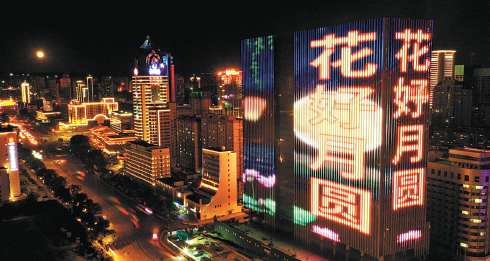Tourism provides boost to nighttime economy
Updated: 2021-09-24

Yingze Avenue is one of the areas in Taiyuan where the nighttime economy is thriving. [Photo by Li Zhaomin for China Daily]
Renovated ancient county seat brings visitors back in time
Walking on the streets of the ancient Taiyuan county seat in the evenings can sometimes give people an experience as if they were walking through history.
They would be transported back to the Ming (1368-1644) and Qing (1644-1911) dynasties when they see the centuries-old streets and traditional folk shows being performed.
However, with the modern lighting along the streets they are quickly reminded they are still in the 21st century.
It is the combination of antiquity and modernity that has brought prosperity to this tourist attraction that only reopened several months ago.
The ancient Taiyuan county seat, which is also called Old Taiyuan, should be the city center of today's Taiyuan, capital of Shanxi province, if not for a devastating fire in the early Song Dynasty (960-1279).
In ancient times, Taiyuan was called Jinyang, and was a city built more than 2,500 years ago.
After nearly 1,500 years of prosperity, the old city was razed by Zhao Guangyi, the second emperor of the Song Dynasty.
Several years later, a newer city was built some 10 kilometers to its northeast, which is today's city of Taiyuan.
During the early Ming Dynasty, local officials built a smaller city on the location of the fire-destroyed site, to act as the seat of Taiyuan county, an administrative region under the jurisdiction of Taiyuan city.
Like many ancient cities in China, Old Taiyuan is no longer intact after wars, winds and rains over the last six centuries. Most of its city walls are gone and many ancient structures destroyed.
In 2013, a renovation project was launched, aimed at restoring Old Taiyuan to its former glory.
After eight years, "new" Old Taiyuan was opened to visitors on May 1.
With city walls rebuilt based on their original appearance and ancient structures inside the city repaired, Old Taiyuan immediately became a new attraction for both tourists and locals.
The number of visitors to the site has grown at such a fast pace that the operators say "this is something beyond their expectations".
"Since May 1, we have received more than 4 million visits," said Su Yawei, deputy general manager of Old Taiyuan Scenic Area.
The executive said the prosperity has been driven by nighttime visits. He noted that nighttime visits can usually account for about two-thirds of the whole-day numbers.
He said there is a trend that visitors tend to spend more at night than in the daytime.
"Our revenue in the past four months was 60 million yuan ($9.27 million), which means a per capita expenditure of 15 yuan based on the total number of 4 million visits," Su said. "But our statistics show that a nighttime visitor spends about 25 yuan on average."
Xia Wenwu, an official at the Taiyuan bureau of commerce, predicted the whole-year revenue of Old Taiyuan can surpass 200 million yuan, making it a new driver for Taiyuan's tourism growth.
He added that Old Taiyuan is driving the nighttime economy in neighboring areas.
"Old Taiyuan is adjacent to such attractions as the Jinyang Lake, Jinyangli scenic area, Jinci Temple and Taishan Mountain," Xia said. "The latter sites are benefiting from the spillover effect of Old Taiyuan's booming nighttime business."
He said that those adjacent attractions have also developed their own nighttime operations when receiving visitors from Old Taiyuan.
"A nighttime economic circle is now taking shape in areas centering on Old Taiyuan," Xia said.
Wu Limin, a researcher at Shanxi Academy of Social Sciences, said the nighttime economy is booming in a number of areas in Taiyuan.
"A nighttime economy cannot develop on its own," Wu said. "It should grow based on the incorporation of resources in commerce, tourism, culture and other sectors."
She noted that such resources can enrich visitor experience and thus bring more revenue.
While Old Taiyuan is using its cultural and historical resources to empower its nighttime economy, Taiyuan Wanxiang Town, a commercial district in the city, has used its resources in commerce, catering and entertainment to develop its nighttime economy.
"This is a place that people can enjoy shopping, dining in restaurants and watching colorful shows on the streets," said one visitor to the area. "It offers relaxing experiences for both children and adults."
Wu said Old Taiyuan and Taiyuan Wanxiang Town represents two options of the nighttime economy that target various customer groups.
While the former is aimed at tourists and nostalgic locals, the latter focuses on the younger generation in the city, Wu said.
Xia of the Taiyuan bureau of commerce said the key to developing Taiyuan's nighttime economy is that the city should have more options for consumers to choose from.
The officials said there are seven sites of the nighttime economy in Taiyuan and another six are planned to be developed this year.
To promote the nighttime economy, Wu suggested the government make efforts in two aspects-offering incentives for businesses to lower operational costs and creating a friendly environment for customers.
Xue Lin contributed to this story.



